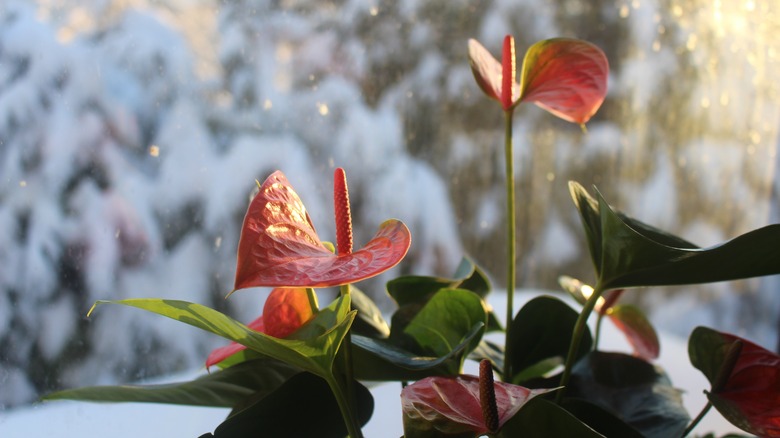Grow This Plant Indoors For Stunning Red Blooms During The Winter
While vibrant flowers are typically associated with outdoor spring or summer gardens, you can still achieve beautiful blooms in winter indoors — as long as you choose the right houseplant. There's one such plant, a herbaceous evergreen perennial (in its preferred USDA Hardiness Zone or when it's grown inside), that produces red, pink, orange, or white flowers throughout the year, including in winter. As one of the trending houseplants for 2025 that you won't want to miss, it's a must-have for anyone looking to brighten up their home. The plant in question? Anthurium andreanum, commonly known as anthurium, flamingo flower, or flamingo lily.
Anthuriums enjoy a tropical climate and can only be grown outdoors year-round in USDA Hardiness Zones 11 to 12. After all, they're native to the Caribbean, Central America, and South America. As a houseplant, they will thrive in any room that stays above 65 degrees Fahrenheit with humidity levels above 50 percent. Though anthuriums are widely considered high-maintenance houseplants, we're sure you'll think their stunning flowers are worth the hassle. Plus, their waxy, heart-shaped leaves add tropical vibes to any space — something that's much needed in the dead of winter.
How to grow anthurium indoors for red winter flowers
Finding the perfect plant for your style can be difficult, but anthuriums are great for anyone looking to add color to their space. Such brightness is especially needed during the winter months, when less sunlight, a lack of green plants, and snow or rain outdoors make everything look drab. After you take your anthurium home, check its pot. If it's planted in a temporary medium, repot it into well-draining soil topped off with moss to maintain warmth and moisture. Anthuriums will tolerate sandy, acidic, and loamy soil, but they don't appreciate overly dry conditions. In the winter, water your anthurium once a week, increasing to twice a week as the weather warms.
Anthuriums require more attention than many other houseplants, particularly if you want them to flower. Mastering the right amount of sunlight is the key to encouraging your plant to bloom in the winter — or any time. Place the houseplant in a spot that receives bright, indirect light, such as a south or west-facing window. If the leaves on your anthurium start to curl or look brown, crispy, or scorched, the plant might be getting too much direct sunlight. Move it to a new, less hazardous spot. Other ways to trigger winter flowering in indoor anthuriums include feeding them with a high-phosphorus fertilizer and regularly deadheading the plant.
Things to keep in mind when growing anthurium indoors
Anthuriums can be a great addition to any room, especially for indoor gardeners longing for a bright splash of color during winter. However, they are not without their downsides. The flamingo flower is a stunning plant pet owners should be wary of for reasons beyond their care requirements. All anthuriums are poisonous if ingested — though the risk the toxins posed by the plant's toxins, calcium oxalate crystals, is low. They still make excellent — and very pretty — cold season houseplants if you take proper precautions.
If there are children or pets living in your home, reconsider growing anthuriums or keep the plants well out of reach. Growing your plant in a hanging basket or high up on a wall or bookshelf can be a good solution, and it allows you to better admire the blooms all winter long. Even if you haven't eaten the plant, it may still lash out. Similar to another red-flowering Christmastime favorite, poinsettia, those with sensitive skin should avoid directly touching the roots, stems, leaves, and flowers of anthurium. Contact with the plant's clear sap can irritate skin. Wear gloves when repotting your plant and when trimming off dead flowers to encourage more winter blooms.


